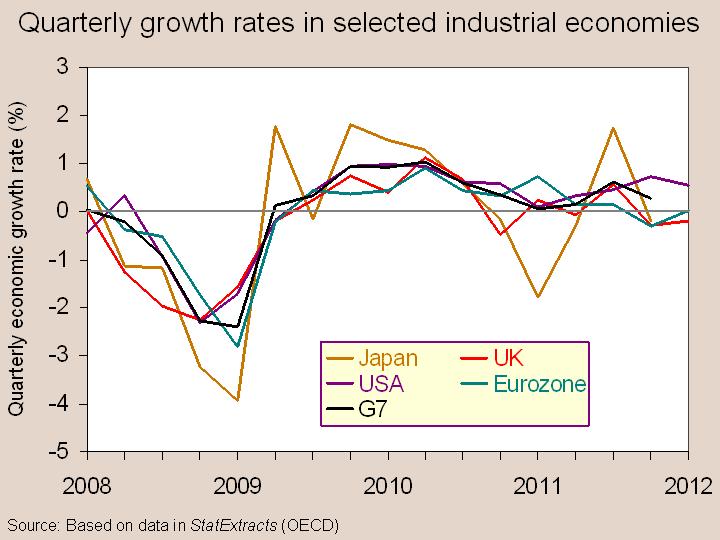 In an attempt to prevent recession following the financial crisis of 2007–8, many countries adopted both expansionary monetary policy and expansionary fiscal policy – and with some success. It is likely that the recession would have been much deeper without such policies
In an attempt to prevent recession following the financial crisis of 2007–8, many countries adopted both expansionary monetary policy and expansionary fiscal policy – and with some success. It is likely that the recession would have been much deeper without such policies
But with growing public-sector deficits caused by the higher government expenditure and sluggish growth in tax receipts, many governments soon abandoned expansionary fiscal policy and relied on a mix of loose monetary policy (with ultra low interest rates and quantitative easing) but tight fiscal policy in an attempt to claw down the deficits.
But such ‘austerity’ policies made it much harder for loose monetary policy to boost aggregate demand. The problem was made worse by the attempt of both banks and individuals to ‘repair’ their balance sheets. In other words banks became more cautious about lending, seeking to build up reserves; and many individuals sought to reduce their debts by cutting down on spending. Both consumer spending and investment were slow to grow.
And yet government and central banks, despite the arguments of Keynesians, were reluctant to abandon their reliance solely on monetary policy as a means of boosting aggregate demand. But gradually, influential international institutions, such as the IMF (see also) and World Bank, have been arguing for an easing of austerity fiscal policies.
 The latest international institution to take a distinctly more Keynesian stance has been the Organisation for Economic Co-operation and Development (OECD). In its November 2015 Economic Outlook it had advocated some use of public-sector investment (see What to do about slowing global growth?. But in its Interim Economic Outlook of February 2016, it goes much further. It argues that urgent action is needed to boost economic growth and that this should include co-ordinated fiscal policy. In introducing the report, Catherine L Mann, the OECD’s Chief Economist stated that:
The latest international institution to take a distinctly more Keynesian stance has been the Organisation for Economic Co-operation and Development (OECD). In its November 2015 Economic Outlook it had advocated some use of public-sector investment (see What to do about slowing global growth?. But in its Interim Economic Outlook of February 2016, it goes much further. It argues that urgent action is needed to boost economic growth and that this should include co-ordinated fiscal policy. In introducing the report, Catherine L Mann, the OECD’s Chief Economist stated that:
“Across the board there are lower interest rates, except for the United States. It allows the authorities to undertake a fiscal action at very very low cost. So we did an exercise of what this fiscal action might look like and how it can contribute to global growth, but also maintain fiscal sustainability, because this is an essential ingredient in the longer term as well.
 So we did an experiment of a two-year increase in public investment of half a percentage point of GDP per annum undertaken by all OECD countries. This is an important feature: it’s everybody doing it together – it’s a collective action, because it’s global growth that is at risk here – our downgrades [in growth forecasts] were across the board – they were not just centred on a couple of countries.
So we did an experiment of a two-year increase in public investment of half a percentage point of GDP per annum undertaken by all OECD countries. This is an important feature: it’s everybody doing it together – it’s a collective action, because it’s global growth that is at risk here – our downgrades [in growth forecasts] were across the board – they were not just centred on a couple of countries.
So what is the effect on GDP of a collective fiscal action of a half a percentage point of GDP [increase] in public investment in [high] quality projects. In the United States, the euro area, Canada and the UK, who are all contributors to this exercise, the increase in GDP is greater than the half percentage point [increase] in public expenditure that was undertaken. Even if other countries don’t undertake any fiscal expansion, they still get substantial increases in their growth rates…
Debt to GDP in fact falls. This is because the GDP effect of quality fiscal stimulus is significant enough to raise GDP (the denominator in the debt to GDP ratio), so that the overall fiscal sustainability [debt to GDP] improves.”
What is being argued is that co-ordinated fiscal policy targeted on high quality infrastructure spending will have a multiplier effect on GDP. What is more, the faster growth in GDP should outstrip the growth in government expenditure, thereby allowing debt/GDP ratios to fall, not rise.
This is a traditional Keynesian approach to tackling sluggish growth, but accompanied by a call for structural reforms to reduce inefficiency and waste and improve the supply-side of the economy.
Articles
Osborne urged to spend more on infrastructure by OECD Independent, Ben Chu (18/2/16)
OECD blasts reform fatigue, downgrades growth and calls for more rate cuts Financial Review (Australia), Jacob Greber (18/2/16)
OECD calls for less austerity and more public investment The Guardian, Larry Elliott (18/2/15)
What’s holding back the world economy? The Guardian, Joseph Stiglitz and Hamid Rashid (8/2/16)
OECD calls for urgent action to combat flagging growth Financial Times, Emily Cadman (18/2/16)
Central bankers on the defensive as weird policy becomes even weirder The Guardian, Larry Elliott (21/2/16)
Keynes helped us through the crisis – but he’s still out of favour The Guardian, Larry Elliott (7/2/16)
G20 communique says monetary policy alone cannot bring balanced growth
Reuters (27/2/15)
OECD publications
 Global Economic Outlook and Interim Economic Outlook OECD, Catherine L Mann (18/2/16)
Global Economic Outlook and Interim Economic Outlook OECD, Catherine L Mann (18/2/16)
Interim Economic Outlook OECD (18/2/16)
Questions
- Draw an AD/AS diagram to illustrate the effect of a successful programme of public-sector infrastructure projects on GDP and prices.
- Draw a Keynesian 45° line diagram to illustrate the effect of a successful programme of public-sector infrastructure projects on actual and potential GDP.
- Why might an individual country benefit more from a co-ordinated expansionary fiscal policy of all OECD countries rather than being the only country to pursue such a policy?
- What determines the size of the multiplier effect of such policies?
- How might a new classical/neoliberal economist respond to the OECD’s recommendation?
- Why may monetary policy have ‘run out of steam’? Are there further monetary policy measures that could be adopted?
- Compare the relative effectiveness of increased government investment in infrastructure and tax cuts as alterative forms of expansionary fiscal policy.
- Should quantitative easing be directed at financing public-sector infrastructure projects? What are the benefits and problems of such a policy? (See the blog post People’s quantitative easing.)
 As we saw in several posts on this site, last year was a tumultuous one for the Greek people and their economy. The economy was on the verge of bankruptcy; the Greek people rejected the terms of a bailout in a referendum; exit from the eurozone and having to return to the drachma seemed likely; banks were forced to closed at the height of the crisis; capital controls were imposed, with people restricted to drawing €60 a day or €420 a week – a policy still in force today; unemployment soared and many people suffered severe hardship.
As we saw in several posts on this site, last year was a tumultuous one for the Greek people and their economy. The economy was on the verge of bankruptcy; the Greek people rejected the terms of a bailout in a referendum; exit from the eurozone and having to return to the drachma seemed likely; banks were forced to closed at the height of the crisis; capital controls were imposed, with people restricted to drawing €60 a day or €420 a week – a policy still in force today; unemployment soared and many people suffered severe hardship.
To achieve the bailout, the Syriza government had to ignore the results of the referendum and agree to harsh austerity policies and sweeping market-orientated supply-side policies. This, at least, allowed Greece to stay in the eurozone. It held, and won, another election to seek a further mandate for these policies.
 But what are the prospects for 2016? Will it be a year of recovery and growth, with market forces working to increase productivity? Does 2016 mark the beginning of the end and, as prime minister Alexis Tsipras put it, “a final exit from economic crisis”?
But what are the prospects for 2016? Will it be a year of recovery and growth, with market forces working to increase productivity? Does 2016 mark the beginning of the end and, as prime minister Alexis Tsipras put it, “a final exit from economic crisis”?
Or will the continuing cuts simply push the economy deeper into recession, with further rises in unemployment and more and more cases of real human hardship? Is there a hysteresis effect here, with the past six years having created a demoralised and deskilled people, with cautious investors unable and/or unwilling to rebuild the economy?
 The article below looks at the rather gloomy prospects for Greece and at whether there are any encouraging signs. It also looks at the further demands of the troika of creditors – the IMF, the ECB and the European Commission’s European Stability Mechanism (ESM) – and at what the political and economic impact of these might be.
The article below looks at the rather gloomy prospects for Greece and at whether there are any encouraging signs. It also looks at the further demands of the troika of creditors – the IMF, the ECB and the European Commission’s European Stability Mechanism (ESM) – and at what the political and economic impact of these might be.
Greece’s economic crisis goes on, like an odyssey without end The Guardian, Helena Smith (4/1/16)
Questions
- Construct a timeline of Greece’s debt repayments, both past and scheduled, and of the bailouts given by the troika to prevent Greece defaulting.
- What supply-side reforms are being demanded by Greece’s creditors?
- What will be the effect of these supply-side reforms in (a) the short run; (b) the long run?
- Explain the meaning of hysteresis as it applies to an economy in the aftermath of a recession. How does the concept apply in the Greek situation?
- Discuss the alternative policy options open to the Greek government for tackling the persistent recession.
- Would it be better for Greece to leave the euro? Explain your arguments.
- “I cannot see how this government can survive the reforms. And I cannot see how it can avoid these reforms.” Is there any way out of this apparent impasse for the Greek government?
 In the third and final part of this blog, we look at the G8 summit at Camp David on 18 and 19 May 2012. Ways of averting the deepening global economic crisis were top of the agenda.
In the third and final part of this blog, we look at the G8 summit at Camp David on 18 and 19 May 2012. Ways of averting the deepening global economic crisis were top of the agenda.
In terms of the global economy, the leaders agreed on three main things. The first was that they supported Greece remaining in the euro. According to the communiqué:
We agree on the importance of a strong and cohesive eurozone for global stability and recovery, and we affirm our interest in Greece remaining in the eurozone while respecting its commitments. We all have an interest in the success of specific measures to strengthen the resilience of the eurozone and growth in Europe
The second was a commitment to ‘fiscal responsibility’ and the clawing down of public-sector deficits.
We commit to fiscal responsibility and, in this context, we support sound and sustainable fiscal consolidation policies that take into account countries’ evolving economic conditions and underpin confidence and economic recovery.
 The third was commitment to boosting economic growth. (Click on chart for a larger image.) On the supply side this would be through measures to stimulate productivity. On the demand side this would be through policies to stimulate investment.
The third was commitment to boosting economic growth. (Click on chart for a larger image.) On the supply side this would be through measures to stimulate productivity. On the demand side this would be through policies to stimulate investment.
(For a PowerPoint of the chart, click on the following link: Quarterly Growth.)
To raise productivity and growth potential in our economies, we support structural reforms, and investments in education and in modern infrastructure, as appropriate. Investment initiatives can be financed using a range of mechanisms, including leveraging the private sector. Sound financial measures, to which we are committed, should build stronger systems over time while not choking off near-term credit growth. We commit to promote investment to underpin demand, including support for small businesses and public-private partnerships.
But the communiqué was short on details. How will fiscal consolidation be achieved? Does this mean a continuation of austerity measures? And if so, what will be the impact on aggregate demand? Or if fiscal consolidation is slowed down, what will be the impact on financial markets?
If a growth in investment is central to the policy, what will be the precise mechanisms to encourage it? Will they be enough to combat the deflationary effect on demand of the fiscal measures?
And how will productivity increases be achieved? What supply-side measures will be introduced? And will productivity increases be encouraged or discouraged by continuing austerity measures?
Lots of questions – questions raised by the articles below.
Articles
Capitalism at a crossroads Independent (19/5/12)
 Barack Obama warns eurozone to focus on jobs and growth The Telegraph (20/5/12)
Barack Obama warns eurozone to focus on jobs and growth The Telegraph (20/5/12)
G8 Summit: World leaders push for Greece to stay in the eurozone The Telegraph, Angela Monaghan (19/5/12)
Obama sees ’emerging consensus’ on crisis Sydney Morning Herald, Ben Feller and Jim Kuhnhenn (20/5/12)
G8 leaders tout economic growth, fiscal responsibility CNN (20/5/12)
G8 focuses on Eurozone Gulf News (20/5/12)
G8 leaders back Greece amid tensions France 24 (20/5/12)
G8 splits over stimulus versus austerity Financial TimesRichard McGregor and Kiran Stacey (19/5/12)
Cameron is consigning the UK to stagnation Financial Times, Martin Wolf (17/5/12)
Time to end ‘Camerkozy’ economics Financial Times, Ed Miliband (18/5/12)
Obama: Eurozone ‘must focus on jobs and growth’ BBC News (20/5/12)
World leaders back Greece, vow to combat financial turmoil Reuters, Jeff Mason and Laura MacInnis (19/5/12)
Germany isolated over euro crisis plan at G8 meeting in Camp David Guardian, Patrick Wintour (19/5/12)
G8 leaders end summit with pledge to keep Greece in eurozone Guardian, Ewen MacAskill (19/5/12)
G8 summit ends with few tangible results Xinhua, Sun Hao (20/5/12)
Final communiqué
Camp David DeclarationG8 (19/5/12)
Questions
- To what extent are economic growth and fiscal consolidation (a) compatible; (b) incompatible objectives? How might a Keynesian and a new classical economist respond to these questions?
- What supply-side measures could be introduced by the EU?
- Why might dangers of protectionism increase in the coming months?
- What would be the impact of a Greek default and exit from the eurozone on other eurozone economies?
- What monetary policy changes could be introduced by the eurozone governments and the ECB in order to ease the sovereign debt crisis of countries such as Grecce, Spain, Portugal, Italy and Ireland?
The global economic mood is darkening. Levels of consumer and producer confidence have declined and forecasts of economic growth are being downgraded. Mervyn King, Governor of the Bank of England, stated that “this is the most serious financial crisis we’ve seen, at least since the 1930s, if not ever” (see).
So will slow recovery turn into a second recession (a double-dip)? And will recession turn into depression – the persistence of low or negative growth over a number of years? The following articles consider this frightening prospect and whether there are similarities with the Great Depression of the 1930s.
But let’s not be too downhearted. If we all are, the world could end up talking itself into depression. Consumers would seek to claw down their debts and cut back spending; producers would invest less as their confidence wanes; banks would be unwilling to lend. So is there any cause to be cheerful? Well, at least world leaders are increasingly aware of the possibility of world depression and minds are increasingly being focused on how to avoid the situation. The EU summit on 23 October and the G20 summit in Cannes on 3/4 November have EU sovereign debt problems and the global crisis at the centre of their agenda.
But if they do decide to act, what should they do? Is the answer a Keynesian stimulus to aggregate demand through fiscal policy and through further quantitative easing? Or is the approach to act more decisively to reduce sovereign debt and convince markets that governments are serious about tackling the problem – a policy response much more in accordance with new classical thinking and the type of policy that would be recommended by Thomas Sargent and Christopher Sims, winners of this year’s Nobel Prize in Economics?
Thinking outside the 1930s box BBC News blogs, Paul Mason (7/10/11)
Britain faces slowest recovery in a century Guardian, Katie Allen (12/10/11)
The Depression: If Only Things Were That Good New York Times, Sunday Review, David Leonhardt (8/10/11)
Recovery has ‘stalled’, say leading economists Financial Times, Sarah O’Connor (11/10/11)
Nobel prize in economics Republica, Opinion (Nepal), Sukhdev Shah (11/10/11)
Questions
- In what ways is the current global economic situation similar to that in the early 1930s?
- In what ways is it different? Do these differences provide more or less cause for hope for avoiding a global depression?
- Explain the following quote from the first article above: “I think that we face the quite real prospect that the market is removed as the determining mechanism for setting the price of capital within the eurozone at the sovereign level.This would put internal credit creation back under the control of the state.”
- How is the supply side of the economy relevant to (a) the short-run prospects for economic growth; (b) the long-run prospects?
- If technological progess slows down, what will be the implications for employment and unemployment? Explain.
- How is policy credibility relevant to the success of the decisions made at G20 and EU summits? (See last aricle above.) How would a Keynesian respond to the analysis of Sargent and Sims?
The quarter 2 UK GDP growth figures were published at the end of July. They show that real GDP grew by a mere 0.2% over the quarter, or 0.7% over 12 months. These low growth figures follow 2010Q4 and 2011Q1 growth rates of –0.5 and 0.5 respectively, giving an approximately zero growth over those six months. The recovery that seemed to be gathering pace in early 2010, now seems to have petered out, or at best slowed right down. According to an average of 27 forecasts, collated by the Treasury, GDP is expected to grow by just 1.3% in 2011 – below the potential rate of economic growth and thus resulting in a widening of the output gap.
With such a slow pace of recovery, current forecasts suggest that it will be 2013 before the economy returns to the pre-recession level of output: just over five years after the start of the recession in 2008. This chart from the National Institute of Economic and Social Research compares the current recession with previous ones and shows how the recovery is likely to be the slowest of the five recessions since the 1930s.
The Confederation of British Industry (CBI) in its latest Economic Forecast says that the economic outlook has become more challenging.
The intensification of euro area sovereign debt pressures has added to the downside risks facing the UK economy – although the agreement reached at the recent summit appears to represent an initial step towards resolving the issues.
Meanwhile the global economy is going through a soft patch, partly as a result of the previous surge in commodity prices, which has put pressure on household budgets and raised costs for businesses.
Against this backdrop confidence appears to have wilted somewhat.
The opposition blames the slow pace of recovery on the austerity measures imposed by the government. The depressing of aggregate demand by cutting government expenditure and raising taxes has depressed output growth. The problem has been compounded by a lack of consumer spending as real household incomes have been squeezed by inflation and as consumers fear impending tax rises and cuts in benefits. And export growth, which was hoped to lead the country’s recovery, has been hit by weak demand in Europe and elsewhere.
With weak growth, the danger is that automatic fiscal stabilisers (i.e. more people claiming benefits and lack of growth in tax revenues) will mean that the government deficit is not cut. This may then force the Chancellor into further austerity, which would compound the problem of low demand. The opposition has thus been calling for a (temporary) cut in VAT to stimulate the economy.
The government argues that rebalancing the budget is absolutely crucial to maintaining international confidence and Britain’s AAA rating by the credit rating agencies, Moody’s, Fitch and Standard and Poor’s (S&P). Any sign that the government is slacking in its resolve, could undermine this confidence. According to George Osborne, while other countries (including the USA and many eurozone countries) are facing a lot of instability, “Britain is a safe haven. We have convinced the world that we can deal with our debts, bring our deficit down, and that’s meant that interest rates, for British families, for British businesses, are lower than they would otherwise be; it means that our country’s credit rating has been affirmed … and it means that we have that crucial ingredient of any recovery – economic stability.”
What is more, the government claims that the essence of the UK’s problem of low growth lies on the supply side. The focus of growth policy, it maintains, should be on cutting red tape, improving efficiency and, ultimately, in reducing taxes.
What we are witnessing is a debate that echoes the Keynesian/new classical debates of the 1980s and earlier: a debate between those who blame the current problem on lack of aggregate demand and those who blame it on supply-side weaknesses, including weaknesses of the banking sector.
So what should be done? Is it time for a (modest) fiscal expansion, or at least a reining in of the fiscal tightening? Should the Bank of England embark on another round of quantitative easing (QE2)? Or does the solution lie on the supply side? Or should policy combine elements of both?
Articles
UK economy grows by 0.2% BBC News (26/7/11)
Economic growth stalls – and slump will carry on until 2013 Independent, Sean O’Grady (27/7/11)
GDP figures mean Britain will miss its economic growth targets Guardian, Julia Kollewe (26/7/11)
UK GDP figures show slower growth of 0.2% BBC News (26/7/11)
UK growth forecast looks unrealistic after GDP fall Independent, Sean O’Grady (27/7/11)
UK set for low growth as the mood ‘darkens’ Independent, Sean O’Grady (1/8/11)
No sign of a U-turn – but there may be a minor course change Scotsman, John McLaren (27/7/11)
George Osborne vows to stick with ‘plan A’ despite UK GDP growth slowdown The Telegraph, John McLaren (27/7/11)
Weak growth may force Chancellor into further austerity The Telegraph, Jeremy Warner (26/7/11)
UK households squeezed harder than US or Europe The Telegraph, Philip Aldrick, and Emma Rowley (30/7/11)
UK Government will have to act if growth remains weak, warns CBI The Telegraph, Philip Aldrick (1/8/11)
UK economy GDP figures: what the experts say Guardian, Claire French (26/7/11)
My plan B for the economy Guardian, Ed Balls, Ruth Lea, Jonathan Portes, Digby Jones and Stephanie Blankenburg (27/7/11)
Not much of a squeeze The Economist, Buttonwood’s notebook (26/7/11)
Some safe haven The Economist (30/7/11)
UK growth – anything to be done? BBC News, Stephanie Flanders (26/7/11)
IMF report on UK: main points The Telegraph, Sarah Rainey (2/8/11)
Families to be £1,500 a year worse off, IMF warns The Telegraph, Philip Aldrick (2/8/11)
IMF casts doubt on UK deficit plan, Financial Times, Chris Giles (1/8/11)
Data and reports
GDP Growth (reliminary estimate) ONS
Gross domestic product preliminary estimate: 2nd Quarter 2011 ONS (26/7/11)
World Economic Outlook Update IMF
OECD Economic Outlook No. 89 Annex Tables OECD (see Table 1)
United Kingdom: IMF Country Report No. 11/220 IMF (2/8/11)
Prospects for the UK economy National Institute of Economic and Social Research (3/8/11)
Questions
- What special ‘one-off’ factors help to explain why the underlying growth in 2011Q2 may have been higher than 0.2%?
- Why is the output gap rising? How may supply-side changes affect the size of the output gap?
- Why is the recovery from recession in the UK slower than in most other countries? Why is it slower than the recovery from previous recessions?
- How may automatic fiscal stabilisers affect (a) economic growth and (b) the size of the public-sector deficit if the output gap widens?
- Distinguish between demand-side and supply-side causes of the slow rate of economic growth in the UK.
- Compare the likely effectiveness of demand-side and supply-side policy measures to stimulate economic growth, referring to both magnitude and timing.
 In an attempt to prevent recession following the financial crisis of 2007–8, many countries adopted both expansionary monetary policy and expansionary fiscal policy – and with some success. It is likely that the recession would have been much deeper without such policies
In an attempt to prevent recession following the financial crisis of 2007–8, many countries adopted both expansionary monetary policy and expansionary fiscal policy – and with some success. It is likely that the recession would have been much deeper without such policies The latest international institution to take a distinctly more Keynesian stance has been the Organisation for Economic Co-operation and Development (OECD). In its November 2015 Economic Outlook it had advocated some use of public-sector investment (see What to do about slowing global growth?. But in its Interim Economic Outlook of February 2016, it goes much further. It argues that urgent action is needed to boost economic growth and that this should include co-ordinated fiscal policy. In introducing the report, Catherine L Mann, the OECD’s Chief Economist stated that:
The latest international institution to take a distinctly more Keynesian stance has been the Organisation for Economic Co-operation and Development (OECD). In its November 2015 Economic Outlook it had advocated some use of public-sector investment (see What to do about slowing global growth?. But in its Interim Economic Outlook of February 2016, it goes much further. It argues that urgent action is needed to boost economic growth and that this should include co-ordinated fiscal policy. In introducing the report, Catherine L Mann, the OECD’s Chief Economist stated that:So we did an experiment of a two-year increase in public investment of half a percentage point of GDP per annum undertaken by all OECD countries. This is an important feature: it’s everybody doing it together – it’s a collective action, because it’s global growth that is at risk here – our downgrades [in growth forecasts] were across the board – they were not just centred on a couple of countries.
 Global Economic Outlook and Interim Economic Outlook OECD, Catherine L Mann (18/2/16)
Global Economic Outlook and Interim Economic Outlook OECD, Catherine L Mann (18/2/16)



